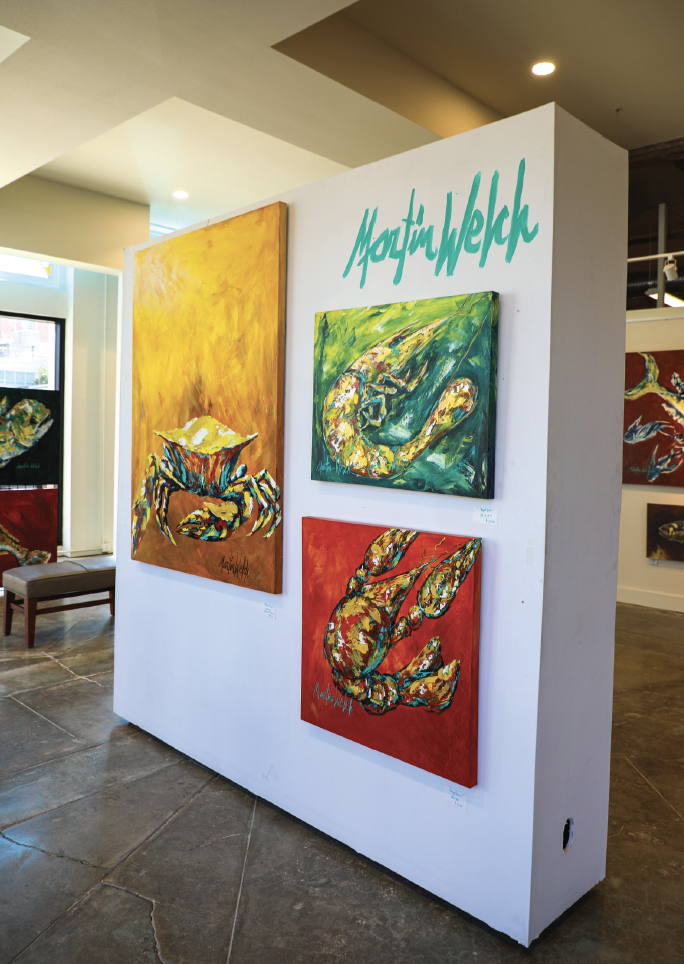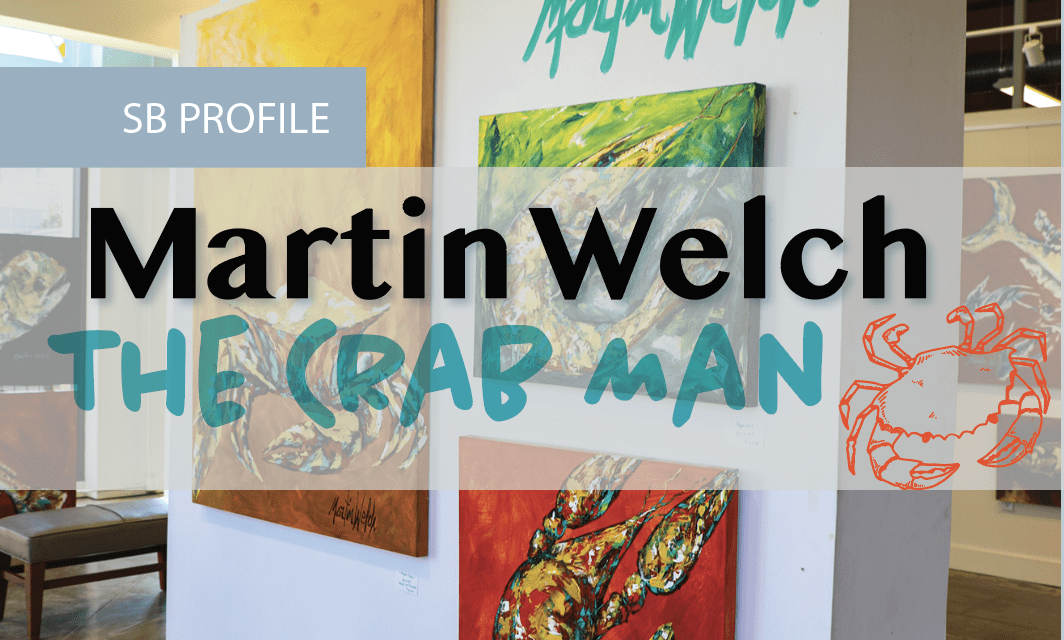by Scott Anderson
The gallery on the main floor of the Andress Artist and Entrepreneur Center in downtown Shreveport is awash in vibrant reds, yellows, and greens. The paintings are a catalog of Louisiana flora and fauna — lily pads, cows, birds, and fish. The centerpiece of the collection is the blue crab — the one that literally made a name for the creator, Martin Welch.
“The crabs are what everybody in New Orleans knew me for,” Welch said. “They used to call me ‘The Crab Man.’”
Welch is as well known in Shreveport for his crabs and other paintings as he is in New Orleans, Gulf Shores, Alabama, and across the region. He came to the Red River Revel fifteen years ago to show his work. It was the beginning of a relationship with the city that continues to this day.
“I met the red apron ladies in Shreveport and fell in love with them,” he said. “The people up here were always so nice. They were always glad to see you and always remember your name. They would always come back every year and buy something different.”
Welch describes Shreveport as a big city with a small-town feel. Some of the people he has met through the years at the Revel feel like family to him. He even found some actual family in local artist Emily Welch and her husband, Johnny.
“I know Johnny and I are related, but I don’t know how,” Martin said. “We have some of the same stories I heard when I was growing up. I think I’m his dad’s age.” Emily refers to Martin as her “art dad” thanks to a coincidence at the Revel. “For two or three Revels, our booths were back-to-back,” Emily said. “Somebody made a comment about it, and it’s carried on to other people.” It’s a label both artists not only embrace but celebrate. “Johnny and I always just love his work,” Emily said. “We would visit with him when he came up for shows. Once I started exhibiting at the Revel, we became closer friends. We started hosting a starving artists breakfast the last day of the Revel. It was made up of artists we enjoyed, purchased their works, and enjoyed being together. Martin is one of those we invited.”

Those relationships are part of the reason Martin continues to come to the Revel.
“It keeps you in connection with that hometown feel,” he said. “They all have their own lives, but you feel connected to them. It’s kind of a weird feeling. Some of the other places are strictly touristy.” Life hasn’t always been bright colors
and art shows for Welch. At 67, he freely reflects on a darker past and his life’s journey to art and his connection to Shreveport.
“I grew up with seven kids in the family, one girl and the rest were boys,” he said. “My mom and dad met when he was in the Army. I lived in Greenwood, Mississippi, out in the country. We had an outhouse. We walked down the dirt road to get to the gravel road to catch the bus to go to school. I didn’t walk uphill to school in the snow, but I did walk in the mud sometimes.”
He describes his childhood as “totally dysfunctional,” with abuse and alcoholism. “It’s the same old stuff that everybody deals with, but they always hid it under the rugs back then,” he said.
“I think that’s why we all escaped into our own little world,” he added. “My sister, she liked music. I liked art. One of my brothers liked to tinker with automobiles. We all just went our own separate ways.”
Martin still remembers his first art lesson. In the second grade, he drew a picture of a house sitting on a green strip of grass with a blue strip of sky across the top of the drawing. The teacher explained to him that the sky and the grass had to meet at the horizon.
It would be years later before he chose to formally study art. He first had to overcome a label put on him in those early years. “I was always told I couldn’t be an artist,” Welch said. “My dad called me a jack of all trades and a master of none.”
Welch started college at Ole Miss before transferring to Delta State University in Cleveland, Mississippi. Back home, his parents were having problems. Ultimately, his mom moved in with him to escape
the turmoil. But before long, Martin was looking for an escape himself, and he found it in the Navy. “My younger brother joined the Navy,” he said. “It was one way to get out of the house and try to do something with your life.”
His younger brother retired from the Navy. Martin served just two years and learned to build transistors. Martin enjoyed
the regimentation of military life, but
he knew it was time for something else. After the Navy, he dabbled in jewelry for a while before finally getting serious about pursuing an art degree.
He enrolled at Springhill College. He not only earned his degree. He graduated Magna Cum Laude and was the President’s Scholar for the art department. He also found the support and validation to pursue his art. “Some of the teachers at Springhill College are good cheerleaders,” he said. “They would say, ‘You’re good. And if you’re good, do something with it.’” So he did.
“I wound up renting this place in Mobile, Alabama,” he said. “It was
a junk store. I lived upstairs. I had
a roof, but I didn’t have a ceiling. I
had to put cardboard up to keep the pigeons out. It’s something you do.
If you want to commit to something, then do it.”
He began buying canvases and painting in his space over the junk store. He would sell the painting in the parking lot. As he built his body of work, he began traveling to regional art shows to build his reputation.


“The art shows were an audience that was attracted by the event,” he said. “You had more of a customer pool than the parking lot of my little junk store in Mobile, Alabama. I could go home and work for two or three weeks and get enough stuff to go to the art shows. Then it started that I was working so much that I had enough stuff to do three weekends a month.”
He was traveling to New Orleans, Gulf Shores, and across the region to showcase his work. It was taking its toll on him. His success at the Revel made resolving the issue an easy choice.
“I would always come up here to do the first half of the week, then go to the Gulf Shores thing,” he said. “That was an ordeal, because we’d pack up here, go pick up stuff in New Orleans and go on to Gulf Shores. But Gulf Shores sales kept going down, and Shreveport kept going up. So then I came here for the whole time.”
Now Martin comes to Shreveport more frequently to work and sell his paintings out of the Andress building. “You can be a success anywhere you want to be,” he said. “Some artists used to paint at their kitchen tables. You can paint anywhere you want to be. It’s just doing it.”
Welch said the structure of his work grew from the Japanese Sumi style, but he prefers bright colors to the traditional black and white.
“It’s kind of a cubist thing,” he said “It’s kind of something I developed on my own. To me, the colors and the subject is nostalgic. But it’s the expression of how I feel at the time.”
His work has always been that way. “A lot of my work when I graduated was dark and introspective,” he added. “It was kind of soul-searching. I still have some in the attic in Mississippi. I still love them, but it’s not something I show a lot.”
The bright colors in his more recent work reflect the growth and change in his personal life. That’s what he enjoys sharing with others.
“I had one customer who bought a painting and put it in her bathroom,” he said. “It was a big, green dragonfly. She said she would get in her tub and look at it and it would just make her happy and start her day the right way. Hearing stories like that just makes you feel good.”
In the end, Welch hopes his life and his career are an inspiration to others to overcome hardship and fear.
“If you struggle enough, regardless of what it is, like financially and everything else, it makes you stronger,” he said. “If you really want to do something to express yourself, it’s not finding a reason to do it. It’s finding you want to do it. I always say I paint with my emotions. I’m painting with what I feel at the time. Having been in such a dark place as a kid, being bright and happy now is one of the reasons why I do the things I do.”

MARTIN WELCH enjoys discovering and sharing people’s stories.
By – Scott Anderson, a freelance writer with more than 20 years’ experience in journalism.









